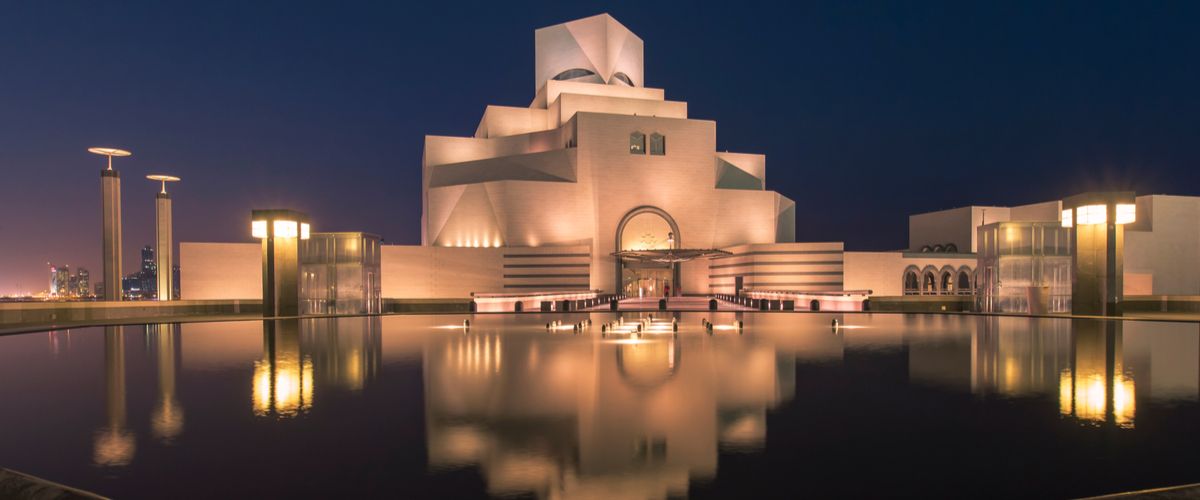Standing majestically on the waterfront of Doha, Qatar, the Museum of Islamic Art is a testament to architectural brilliance. Its iconic design, a seamless blend of traditional Islamic motifs and modern architectural principles, has captivated the world. Behind this masterpiece lies the visionary architect, I. M. Pei, a name synonymous with groundbreaking designs that have re-shaped the skylines of cities around the globe.

Image: www.myholidays.com
The Museum of Islamic Art is not merely a repository of Islamic art and culture; it’s a testament to Pei’s genius, a beacon of architectural innovation, and a symbol of Qatar’s commitment to preserving and promoting its rich heritage. Pei’s remarkable career, spanning decades and continents, is interwoven with this iconic structure, making it a compelling story of innovation and cultural understanding.
I. M. Pei: A Legacy of Architectural Prowess
I. M. Pei, born in 1917 in Guangzhou, China, is a legend in the world of architecture. His early life was shaped by the rich cultural heritage of his homeland, which profoundly influenced his artistic vision. After emigrating to the United States, Pei’s talent blossomed under the tutelage of renowned architect Marcel Breuer. His career took off in the 1950s, marked by the founding of his own firm, I. M. Pei & Partners.
Pei’s architectural philosophy is rooted in a deep understanding of the context and history of each project. He believes in creating structures that are both aesthetically pleasing and functionally efficient. His signature style is characterized by a minimalist approach, geometric forms, and a focus on light and space. He often incorporates elements from the surrounding environment into his designs, creating a harmonious blend between modernity and tradition.
The Museum of Islamic Art: A Symbol of Cultural Exchange
For the Museum of Islamic Art, Pei envisioned a structure that would not only house a remarkable collection of Islamic art but also serve as a bridge between cultures. The museum’s design draws inspiration from Islamic architecture, notably the geometric patterns and intricate details found in mosques and palaces. The building’s central dome, reminiscent of traditional Islamic architecture, is inspired by the Qubbat al-Sakhra (Dome of the Rock) in Jerusalem.
The geometric shapes, the use of natural materials like limestone and marble, and the interplay of light and shadow all contribute to a sense of serenity and spirituality, creating an experience that is both visually stunning and intellectually stimulating. Pei’s genius lies in his ability to weave traditional and modern elements together seamlessly, crafting a structure that speaks to both the past and the present.
Pei’s Vision for a Modern Islamic Art Museum
Pei conceived the Museum of Islamic Art as a space where visitors could immerse themselves in the beauty and diversity of Islamic art and culture. The building’s design reflects this vision, encouraging visitors to journey through different eras and regions, exploring the intricate artistry that defines Islamic art.
The museum’s central courtyard, with its reflecting pool and cascading fountains, acts as a focal point. It offers a tranquil space for reflection and contemplation, a moment of pause amidst the rich narratives and artifacts on display. The museum’s galleries, arranged chronologically, showcase the evolution of Islamic art, from its origins in the 7th century to its contemporary expressions.

Image: www.viator.com
Pei’s Legacy: A Lasting Impact
The Museum of Islamic Art is not just an architectural masterpiece; it’s a statement of cultural significance. It’s a testament to the power of architectural design to transcend cultural differences and foster understanding. Pei’s legacy extends beyond this single project; he has left an indelible mark on the world with his iconic structures, from the Louvre Pyramid in Paris to the Rock and Roll Hall of Fame in Cleveland.
Pei’s buildings are not just spaces; they are experiences. They invite visitors to engage with their surroundings, to reflect on the history and culture that shaped them. His work serves as a reminder of the enduring power of art and architecture to inspire, connect, and unite.
Tips and Expert Advice: Architectural Insights
For aspiring architects and architecture enthusiasts, Pei’s legacy offers valuable insights. His meticulous attention to detail, his understanding of context, and his ability to blend tradition with modernity are all hallmarks of his success. Here are some tips inspired by Pei’s approach:
Firstly, embrace the power of context. Every building is unique, and its design should reflect its location, its history, and the culture it embodies. Secondly, don’t shy away from experimentation and innovation. Pei’s groundbreaking designs pushed the boundaries of architectural design, embracing bold forms and unconventional materials. Finally, strive for functionality and elegance. A well-designed building should not only be aesthetically pleasing but also serve its purpose efficiently and enhance the lives of those who interact with it.
FAQs: Understanding the Architect of the Museum of Islamic Art
- Q: What is the most significant aspect of Pei’s design for the Museum of Islamic Art?
- A: Pei’s masterpiece successfully married the distinct elements of modern and Islamic architecture, resulting in a visually harmonious structure.
<li><strong>Q: How did Pei's upbringing influence his architectural style?</strong></li>
<li>A: Pei's childhood in China and his exposure to traditional Chinese architecture instilled a deep appreciation for the relationship between art, culture, and architecture in his work.</li>
<li><strong>Q: What are some of Pei's other notable projects?</strong></li>
<li>A: Aside from the Museum of Islamic Art, some of Pei's most notable designs include the iconic Louvre Pyramid in Paris and the John F. Kennedy Library in Boston.</li>Architect Of Museum Of Islamic Art Doha
Conclusion: A Masterpiece Built on Cultural Resonance
I. M. Pei’s Museum of Islamic Art is more than just a building; it’s a cultural touchstone. It speaks to both the rich history of Islamic art and the enduring power of modern design. Pei’s genius lies in his ability to weave together these seemingly divergent threads, creating a structure that is both beautiful and meaningful.
Are you an architecture enthusiast? Do you find yourself captivated by the Museum of Islamic Art? Share your thoughts in the comments below!





